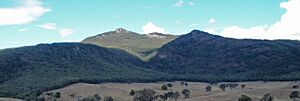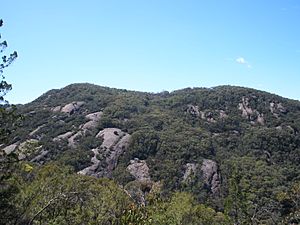Pine Mountain (Victoria) facts for kids
Pine Mountain is a giant rock formation in Australia. It's so big, some people say it's 1.5 times larger than Uluru! You can find it inside the beautiful Burrowa-Pine Mountain National Park.
Contents
Exploring Pine Mountain's Location
Pine Mountain is located about 10 kilometers (6 miles) southeast of a small town called Walwa, Victoria. If you're driving from Melbourne, it's a long trip – about 440 kilometers (273 miles) northeast. From Albury-Wodonga, it's closer, around 115 kilometers (71 miles) east.
Discovering Burrowa-Pine Mountain National Park
Pine Mountain is part of the Burrowa-Pine Mountain National Park. This park is a great place to explore! It has many tracks for 4WD vehicles and walking trails. You can also find pretty waterfalls, picnic spots, and places to camp. The park is known for its wild and rugged feel, which makes it a special place to visit. Another tall peak in the park is Mount Burowa, which stands 1300 meters (4,265 feet) high.
The Geology of Pine Mountain
Pine Mountain is thought to be the biggest single rock in Australia. It's a massive red granite rock that was pushed up to its current height of 1062 meters (3,484 feet) over 2 million years ago. Over time, wind and water have shaped it. This erosion has made the eastern side very steep. It has also created several creeks.
Unique Features of the Mountain
In the higher parts of Pine Mountain, you can find small rock pools. Even though these pools dry up every year, they are home to tiny shrimp and tadpoles! You might also see large granite "marbles." These are huge, round rocks that are about 2 to 3.5 meters (6.5 to 11.5 feet) wide.
Plants of Pine Mountain
Pine Mountain has many different types of plants. It's very important for plants because it's home to several rare and endangered species. More than 200 native plants have been found here. Nineteen of these are rare or only grow in this local area.
Rare and Special Plants
Some of the rare plants you might find include the Pine Mountain Grevillea (Grevillea jephcottii) and the Fan Grevillea (Grevillea ramosissima). Other special plants are the Broad-leafed Hopbush (Dodonaea rhombifoli) and the Phantom Wattle (Acacia phasmoides). You can also see Black Cypress-pines and Kurrajongs growing around the steep granite rocks.
Animals of Pine Mountain
Pine Mountain is full of amazing animal life! You can find many different kinds of animals here.
Common Animals to Spot
Black wallabies, eastern grey kangaroos, and wombats are very common. You might also see possums and gliders. The lyre bird is rarely seen, but you can often hear its unique calls. Over 180 different types of birds have been recorded living in the park.
Hiking the Pine Mountain Track
There is a walking track that starts from the west side of Pine Mountain. This track goes over large granite rocks and leads to the very top of the mountain. To reach the start of the track, you need to drive about 5 kilometers (3 miles) on a 4WD track. This track can only be used when the weather is dry.
Is the Summit Walk for You?
The walk to the summit is very challenging. It's only for experienced hikers who are fit and good at finding their way. The trip to the top is long and takes a lot of effort. It includes several steep rock climbs and descents. It's a good idea to have rock climbing skills and experience if you plan to do this walk.
Staying Safe on the Trail
The weather on Pine Mountain can change very quickly. Always be prepared with warm and waterproof clothes. Bring plenty of high-energy food and enough water. The walking track is about 12 kilometers (7.5 miles) long. It usually takes about 8 hours to go there and back. It might take longer if you are not very fit or are carrying heavy gear.
The path is marked with markers on trees and piles of rocks called cairns. However, sometimes the track is hard to see. So, it's important to carry a map and a compass. Make sure you know how to use them properly.
Views from the Summit
From the top of Pine Mountain, you'll get amazing views! You can see the surrounding Murray River Valleys and the Snowy Mountains in New South Wales.
An Easier Walk: Rocky Knob
If you're looking for a shorter adventure, there's also a small walk to Rocky Knob. This walk is only 2 kilometers (1.2 miles) long and takes about 1 hour to complete.



